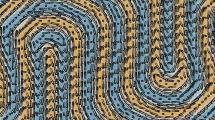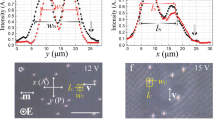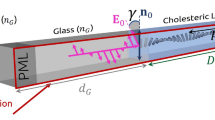Abstract
Motivated by recent mathematical studies of Fréedericksz transitions in twist cells and helix unwinding in cholesteric liquid crystal cells [(da Costa et al. in Eur J Appl Math 20:269–287, 2009), (da Costa et al. in Eur J Appl Math 28:243–260, 2017), (McKay in J Eng Math 87:19–28, 2014), (Millar and McKay in Mol Cryst Liq Cryst 435:277/[937]–286/[946], 2005)], we consider a model for the director configuration obtained within the framework of the Frank-Oseen theory and consisting of a nonlinear ordinary differential equation in a bounded interval with non-homogeneous mixed boundary conditions (Dirichlet at one end of the interval, Neumann at the other). We study the structure of the solution set using the depth of the sample as a bifurcation parameter. Employing phase space analysis techniques, time maps, and asymptotic methods to estimate integrals, together with appropriate numerical evidence, we obtain the corresponding novel bifurcation diagram and discuss its implications for liquid crystal display technology. Numerical simulations of the corresponding dynamic problem also provide suggestive evidence about stability of some solution branches, pointing to a promising avenue of further analytical, numerical, and experimental studies.













Similar content being viewed by others
Notes
Preliminary results, [15], seem to show that the analysis will follow the same lines as presented here and the results will be similar, with the main difference being the destruction of the transcritical bifurcation points at \(T^*, T_j^*\) in the diagram of Fig. 11 in a way similar to what happened in [5] when compared with [4].
Recall the notation \(a\wedge b = \min \{a, b\},\)
Observe that, due to (40), if the interval \((\phi ^\star , \sqrt{z^\star })\) is not empty the piece of the solution branch \(I_k\) with \(\sqrt{z}\) in this interval is monotonic and so the minima of the \(I_k\) branch must necessarily correspond to values \(\sqrt{z}< \phi ^\star \).
References
Arakelyan, S.M., Karayan, A.S., Chilingaryan, Y.S.: Fréedericksz transition in nematic liquid crystals in static and light fields: general features and anomalies. Sov. Phys. Dokl. 29, 202–204 (1984)
Belyakov, V.A.: Untwisting of the helical structure in a plane layer of chiral liquid crystal. JETP Lett. 76, 88–92 (2002)
Chen, H.-W., Lee, J.-H., Lin, B.-Y., Chen, S., Wu, S.-T.: Liquid crystal display and organic light-emitting diode display: present status and future perspectives. Light Sci. Appl. 7, 17168 (2018)
da Costa, F.P., Gartland Jr., E.C., Grinfeld, M., Pinto, J.T.: Bifurcation analysis of the twist-Fréedericksz transition in a nematic liquid-crystal cell with pre-twist boundary conditions. Eur. J. Appl. Math. 20, 269–287 (2009)
da Costa, F.P., Méndez, M.I., Pinto, J.T.: Bifurcation analysis of the twist-Fréedericksz transition in a nematic liquid-crystal cell with pre-twist boundary conditions: the asymmetric case. Eur. J. Appl. Math. 28, 243–260 (2017)
de Gennes, P.G.: Calcul de la distorsion d’une structure cholesterique par un champ magnetique. Solid State Commun. 6, 163–165 (1968)
de Gennes, P.G., Prost, J.: The Physics of Liquid Crystals, International Series of Monographs On Physics, vol. 83. Oxford University Press, Oxford (1993)
Deuling, H.J.: Deformation of nematic liquid crystals in an electric field. Mol. Cryst. Liq. Cryst. 19, 123–131 (1972)
Dreher, R.: Remarks on the distortion of a cholesteric structure by a magnetic field. Solid State Commun. 13, 1571–1574 (1973)
Gartland Jr., E.C., Huang, H., Lavrentovich, O.D., Palffy-Muhoray, P., Smalyukh, I.I., Kosa, T., Taheri, B.: Electric-field induced transitions in a cholesteric liquid-crystal film with negative dielectric anisotropy. J. Comp. Theor. Nanosci. 7(4), 709–725 (2010)
Gartland Jr., E.C.: Forces and variational compatibility for equilibrium liquid crystal director models with coupled electric fields. Continuum Mech. Thermodyn. 32, 1559–1593 (2020)
Kedney, P.J., Stewart, I.W.: The untwisting of a bounded sample of cholesteric liquid crystal. Continuum Mech. Thermodyn. 6, 141–148 (1994)
Kiselev, A.D., Sluckin, T.J.: Twist of cholesteric liquid crystal cells: stability of helical structures and anchoring energy effects. Phys. Rev. E 71, 031704 (2005)
Korman, P.: Global Solution Curves for Semilinear Elliptic Equations. World Scientific, Singapore (2012)
Lorvanhxay, A.: Time Maps in the Study of Some Boundary Value Problems for Ordinary Differential Equation Problems in the Bounded Interval. National University of Laos, Vientiane (2019). (MSc thesis)
McKay, G.: Unwinding of a cholesteric liquid crystal and bidirectional surface anchoring. J. Eng. Math. 87, 19–28 (2014)
Meyer, R.B.: Distortion of a cholesteric structure by a magnetic field. Appl. Phys. Lett. 14, 208–209 (1969)
Millar, H., McKay, G.: Director orientation of a twisted nematic under the influence of an in-plane magnetic field. Mol. Cryst. Liq. Cryst. 435, 277/[937]–286/[946] (2005)
Sackmann, E., Meiboom, S., Snyder, L.C., Meixner, A.E., Dietz, R.E.: Structure of the liquid crystalline state of cholesterol derivatives. J. Am. Chem. Soc. 90, 3567–3569 (1968)
Scarfone, A.M., Lelidis, I., Barbero, G.: Cholesteric-nematic transition induced by a magnetic field in the strong-anchoring model. Phys. Rev. E 84, 021708 (2011)
Schaaf, R.: Global Solution Branches of Two Point Boundary Value Problems. Lecture Notes in Mathematics, vol. 1458. Springer, Berlin, Heidelberg (1990)
Smoller, J.: Shock Waves and Reaction-Diffusion Equations, 2nd Ed., Grundlehren der mathematischen Wissenschaften vol. 258. Springer, New York (1994)
Stewart, I.W.: The Static and Dynamic Continuum Theory of Liquid Crystals: A Mathematical Introduction, The Liquid Crystals Book Series 2. Taylor & Francis, London (2004)
van Sprang, H.A., van de Venne, J.L.M.: Influence of the surface interaction on threshold values in the cholesteric-nematic phase transition. J. Appl. Phys. 57, 175–179 (1985)
Acknowledgements
FPdC and JTP were partially funded by FCT/Portugal through project CAMGSD UID/MAT/04459/2020. FPdC acknowledges financial support provided by the University of Strathclyde David Anderson Research Professorship. This work started while FPdC was staying at the Department of Mathematics of the Faculty of Natural Sciences of the National University of Laos, Vientiane, Laos, with the support of an Erasmus Mundus Mobility with Asia grant EMMA ID 2601. The hospitality of NUOL is gratefully acknowledged. Part of this work was undertaken while NJM was employed at the University of Strathclyde. We thank R. Sasportes for his help with the figures.
Author information
Authors and Affiliations
Corresponding author
Additional information
Publisher's Note
Springer Nature remains neutral with regard to jurisdictional claims in published maps and institutional affiliations.
Appendix
Appendix
In this Appendix we make some remarks about Conjecture 1.
We recall that the determination of the sign of \(\frac{\partial ^2 T_B}{\partial z^2}(z,\phi )\) directly using (33) seems to be a difficult problem due to the balance between the (positive) integral terms and the nonintegral term that has different signs in different regions of the rectangle \( (0,2)\times (0,\frac{\pi }{2})\).
Thus, we tried several, less direct, approaches to the convexity of \(T_B(z,\phi ).\) One such approach was the standard method presented in Smoller [22, Chap. 13§D]: to establish the convexity of \(T_B(z,\phi )\) it is sufficient to prove that
if \((z,\phi )\in (0,2)\times (0,\frac{\pi }{2})\) is a stationary point of \(z\mapsto T_B(z,\phi )\), for all functions \(k(z,\phi )\), because at stationary points the value of the first derivative \(\frac{\partial T_B}{\partial z}\) is zero, by definition. Thus, if we find a function \(k(z,\phi )\) such that (47) holds for all points \((z,\phi )\), we conclude that, for each fixed \(\phi \), \(\Phi (\cdot ,\phi )\) is convex at each of its stationary points, and thus there can exist only one stationary point.
Now, by (27), (33), and (34), choosing
we get
where
From the definition of k it follows that \(k <0\) whenever \(g>0\) and, from (49), (50), and \(h(z,\phi , x) < h(z,\phi ,0),\) we easily conclude that \(\Phi (z,\phi ) > 0\) in \(\Omega := \left\{ (z,\phi )\in {\mathbb {R}}^2 \,|\, 3-k(z,\phi )h(z,\phi ,0) > 0\right\} .\) This set \(\Omega \) is illustrated in Fig. 14.
Outside \(\Omega \) the sign of \(\Phi \) is much harder to establish since the two integrals can have opposite signs and be divergent on the boundaries of the domain of \(\Phi \). However, the positivity of \(\Phi (z,\phi )\) everywhere in the rectangle \((0,2)\times (0, \frac{\pi }{2})\) is easy to get numerically, as illustrated in Fig. 15 obtained using the software Mathematica©.
Alternative approaches to prove the existence of a single minimum of the graph of \(z\mapsto T_B(z,\phi )\), based on attempting to define different type of time maps via changes of variables [14, 21] or other analytic approaches [14] were fruitless. Proving Conjecture 1 remains a technical challenge.
Rights and permissions
About this article
Cite this article
da Costa, F.P., Grinfeld, M., Mottram, N.J. et al. Steady state solutions in a model of a cholesteric liquid crystal sample. Afr. Mat. 32, 645–672 (2021). https://doi.org/10.1007/s13370-020-00851-9
Received:
Accepted:
Published:
Issue Date:
DOI: https://doi.org/10.1007/s13370-020-00851-9
Keywords
- Non-homogeneous two-points boundary value problems
- Bifurcations
- Asymptotic evaluation of integrals
- Cholesteric liquid-crystal cells
- Fréedericksz transition
- Nonlinear pendulum






